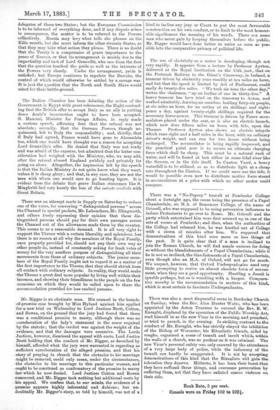The use of electricity as a motor is developing,though not
very rapidly. It appears from a lecture by Professor Ayrton, delivered at the Royal Institution on the Lith_inst., that on the Portrush Railway to the Giant's Causeway, in Ireland, a tramcar driven by electricity runs steadily at ten miles an hour, and but that the speed is limited by Act of Parliament, could easily do twenty-five miles. "We took six tons the other day," writes the chairman, "up an incline of one in thirty-five." A heavy tramcar has been tried on the tramway to Acton, and. worked admirably, drawing an omnibus holding forty-six people, at six miles an hour, for an outlay of six shillings and eight-. pence a day, against twenty-eight shillings required for the necessary horse-power. This tramcar is driven by Faure accu- mulators placed under the seat, as is also an electric launch, which now does fifteen miles an hour, with tide,. upon the Thames. Professor Ayrton also shows an electric tricycle which runs eight and a half miles in the hour, with an ordinary driver's weight, and can run for two hours without being recharged. The accumulator is being rapidly improved, and the practical point now is to secure an ultimate charging force which shall be cheap. This must be a natural rush of water, and will be found at last either in some tidal river like the Severn, or in the tide itself In Canton Vaud, a heavy waterfall is to be utilised, so as to distribute light at a cheap rate throughout the Canton. If we could once use the tide, it would be possible even now to distribute motive force stored in accumulators at a price with which no other motor could compare.


































 Previous page
Previous page